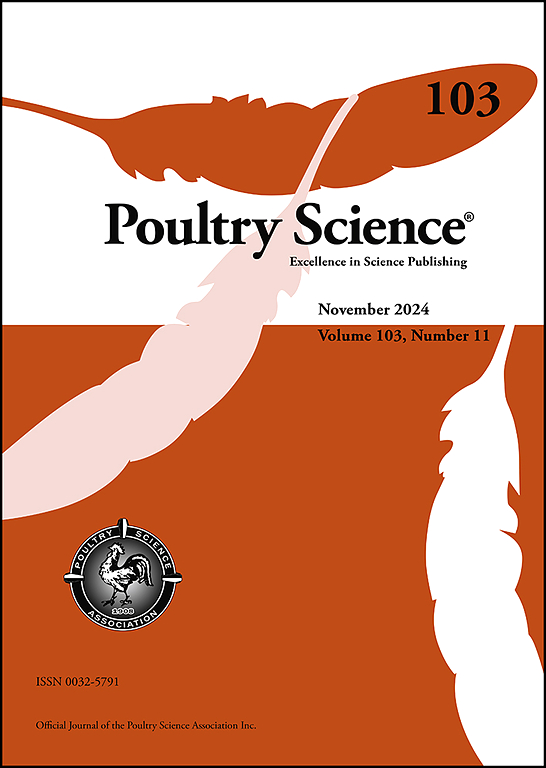天府绿壳蛋鸡不同产蛋阶段快、慢羽菌株生产性能、蛋品质及卵巢免疫功能的比较分析
IF 3.8
1区 农林科学
Q1 AGRICULTURE, DAIRY & ANIMAL SCIENCE
引用次数: 0
摘要
本试验的目的是比较和评价不同羽毛生长速度的天府绿壳蛋鸡的生产性能、鸡蛋品质和免疫功能,为其合理利用提供参考。通过羽毛长度表型鉴定和qPCR分子鉴定,将120只1日龄健康天府绿壳蛋鸡分为早长羽(EF)组和晚长羽(LF)组。每组又分为四个重复,每个重复 30 只鸡。在相同的饲养和管理条件下,评估和分析活重、胫骨长度、产蛋性能、鸡蛋质量、血清生化指标、免疫蛋白含量以及子宫和卵巢组织中相关基因的表达。结果表明,与EF母鸡相比,LF母鸡在4周、16周、27周和43周的活重明显增加(P < 0.05),在4周和16周的胫骨长度明显增加(P < 0.05),这表明LF母鸡的早期生长性能有所提高。相反,尽管蛋重较轻(P < 0.05),但 EF 母鸡的产蛋性能优越,在产蛋高峰期(27 周)和产蛋后期(43 周)产蛋率均较高(P < 0.05)。此外,英系母鸡在产蛋高峰期生产的鸡蛋蛋壳明显更厚、更结实(P < 0.05),而在其他鸡蛋质量参数方面未观察到明显差异。在免疫学方面,与长毛鸡相比,长毛鸡血清中 IgA、IgG 和 IgM 的峰值水平升高。此外,卵巢中 IFN-γ 和白细胞介素 6 (IL-6) 基因的表达水平也明显高于 EF 型母鸡。这些研究结果表明,虽然低频蛋鸡在早期生长阶段表现优异,但高频蛋鸡表现出更高的产蛋能力和更强的免疫反应。本文章由计算机程序翻译,如有差异,请以英文原文为准。
Comparative analysis of the performance, egg quality and ovarian immune function of fast and slow feather strains in tianfu green shell laying hens at various stages of egg production
This objective of this experiment was to compare and evaluate the performance, egg quality, and immune function of Tianfu green shell laying hens with varying feather growth rates, in order to provide a reference for their rational utilization. A total of 120 one-day-old healthy Tianfu green shell laying hens were classified into the early-feathering (EF) and late-feathering (LF) groups through phenotypic identification of feather length and qPCR molecular identification. Each group was subdivided into four replicates, with 30 chickens in each replicate. Under the identical feeding and management conditions, the live weight, tibial length, egg production performance, egg quality, serum biochemical indexes, immune protein content, and the expression of related genes in uterine and ovarian tissues were assessed and analyzed. The results indicated that LF hens exhibited significantly greater live weights at 4, 16, 27, and 43 weeks (P < 0.05) and longer tibia lengths at 4 and 16 weeks (P < 0.05) compared to EF hens, suggesting enhanced early growth performance. Conversely, EF hens demonstrated superior egg-laying performance, characterized by a higher laying rate during both peak (27 weeks) and late (43 weeks) laying periods (P < 0.05), despite their eggs being lighter in weight (P < 0.05). Furthermore, EF hens exhibited the production of eggs with significantly thicker and stronger shells during the peak laying period (P < 0.05), while no notable differences were observed in other egg quality parameters. Immunologically, EF hens demonstrated elevated peak serum levels of IgA, IgG, and IgM compared to LF hens. Additionally, the expression levels of IFN-γ and interleukin 6 (IL-6) genes in the ovaries were markedly higher in EF hens. These findings indicate that although LF hens excel in early growth stages, EF hens exhibit superior egg production capabilities and enhanced immune responses.
求助全文
通过发布文献求助,成功后即可免费获取论文全文。
去求助
来源期刊

Poultry Science
农林科学-奶制品与动物科学
CiteScore
7.60
自引率
15.90%
发文量
0
审稿时长
94 days
期刊介绍:
First self-published in 1921, Poultry Science is an internationally renowned monthly journal, known as the authoritative source for a broad range of poultry information and high-caliber research. The journal plays a pivotal role in the dissemination of preeminent poultry-related knowledge across all disciplines. As of January 2020, Poultry Science will become an Open Access journal with no subscription charges, meaning authors who publish here can make their research immediately, permanently, and freely accessible worldwide while retaining copyright to their work. Papers submitted for publication after October 1, 2019 will be published as Open Access papers.
An international journal, Poultry Science publishes original papers, research notes, symposium papers, and reviews of basic science as applied to poultry. This authoritative source of poultry information is consistently ranked by ISI Impact Factor as one of the top 10 agriculture, dairy and animal science journals to deliver high-caliber research. Currently it is the highest-ranked (by Impact Factor and Eigenfactor) journal dedicated to publishing poultry research. Subject areas include breeding, genetics, education, production, management, environment, health, behavior, welfare, immunology, molecular biology, metabolism, nutrition, physiology, reproduction, processing, and products.
 求助内容:
求助内容: 应助结果提醒方式:
应助结果提醒方式:


